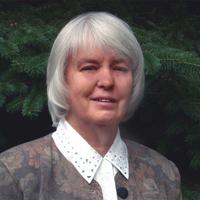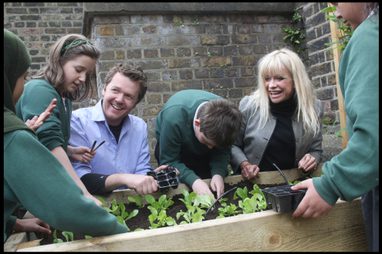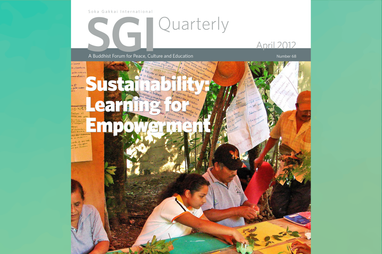SGI Quarterly

Pam Puntenney is an environmental educator, consultant and author, founder and executive director of the Environmental & Human Systems Management consulting firm. She is co-chair of the United Nations Commission on Sustainable Development (UNCSD) Education Caucus, the primary objective of which is to work within the UN system to promote policies that support education and sustainable development.
SGI Quarterly: What inspired you personally to believe that environmental education is key to enabling us to respond to complex global challenges?
Pam Puntenney: It started with growing up in the Kansas countryside surrounded by nature. We lived in a small community of about 800 families with kids discovering the natural world on a daily basis. Then when I did my teacher training, we were taught to focus on creating a community within the classroom, the school and with the community in which the schools were situated.
The time I spent earning a graduate degree through the University of Michigan’s School of Natural Resources and Environment was my major tipping point. We questioned systems and interrelationships; we studied issues from an interdisciplinary perspective; we learned to talk with and read many fields of science—both the natural and human sciences; we learned to communicate, write press releases and professional articles, create policy briefings; we learned how to work in teams, work with stakeholders; we learned about the role of spirituality in community work, the rights of people, the rights of nature, and much more from the local to the international stage.
SGIQ: The UNCSD Education Caucus has played a key role in promoting the concept of a “well-prepared society.”
PP: Yes. It has been well known for several decades that governments can’t solve the global crisis alone, it takes everyone doing what they can from donating to or becoming a member of an organization, to personal choices, to playing a leadership role.
In 2007, the Education Caucus organized a large delegation for the United Nations Framework Convention on Climate Change (UNFCCC) meeting in Bali, Indonesia. We discovered that the “human dimensions” were missing in the proposed Bali Action Plan. We drew attention to the fact that the mitigation of and adaptation to the impacts of climate change were dependent upon “a well-prepared society” through environmental education. We struck a chord: there was a deep concern expressed by many countries about their own societies not being well-prepared.
SGIQ: How can we avoid a situation where the more we know about the crisis of the environment, the more hopeless we feel?
PP: Today too many people start with “I have a nightmare,” followed by “Oh, isn’t it awful.” Martin Luther King Jr., dealing with horrendous civil rights violations and abuses, focused people on the message “I have a dream. . .”; and people were inspired, became better informed, and acted on their knowledge to change the situation. Most of the messages we hear are from the “I have a nightmare” scenario.
We must begin with ourselves and do what we can to address the issues. Young people are inspiring and have ideas about how to improve or address a serious issue in their community, their school, within their social group, and sometimes use amazing creativity drawing from the arts.
It is vital to make visible what is happening. What is our ‘We have a dream’ message?
SGIQ: Can you describe some successful innovative approaches to nonformal environmental education?
PP: My favorite is the creation of the Global Youth Action Network in the mid-90s by an 18-year-old and a 22-year-old who believed young people had something positive to contribute to bettering the world they would inherit. Using Internet technology and an open, inclusive approach, by 2003 they had over 5 million young people setting up projects in the communities where they lived that would make a difference. They have also been very influential on the global stage within the United Nations.
Another example can be found in South Africa where environmental education is the lens through which the Wildlife and Environment Society of South Africa engages communities in sustainability, addressing poverty, using appropriate and innovative technologies such as inexpensive cell phones to improve lives, communication and coordination, and people are acting on their knowledge.
SGIQ: What is missing?
PP: It is vital to make visible what is happening. There are thousands of initiatives going on worldwide where people are simply tackling the key issues within their own context. We rarely have the opportunity to hear about this or let it inspire us in our own work. What is our “We have a dream” message?
Environmental education can engage people at all levels from the president to the ordinary person, finding the starting point and guiding principles to see us forward.
We need new messages that open doors to knowledge-sharing and building systems of learning that lead to action within our communities and with those outside our personal communities. We need to understand using our own processes; we need to inspire, to encourage and engage.
SGIQ: What is your dream outcome from Rio+20?
PP: My dream outcome from the second Earth Summit is a global acknowledgment that the environment—natural systems—is nonnegotiable unlike the social-cultural and economic components.
From the Education Caucus Statement to the Rio+20 UNCSD
-
1
As global crises increase in pace, what we knew yesterday does not apply today.
-
2
No longer can we seek solutions to problems one at a time. Global environmental policies transcend traditional boundaries between sectors, nationalities, cultures and generations. We all need to be able to recognize increasingly complex and inter-related issues where attempts to ameliorate one can alter or even exacerbate the impacts of another.
-
3
New knowledge of how multiple stressors affect human and natural systems requires decision-makers to have an ability to translate knowledge and awareness into usable information, enabling them to make wise short-term judgments as scientific and local, national, and regional information is improved.
-
4
At the time of UNCED in 1992, Governments and non-governmental organizations (NGOs) repeatedly pointed to education as a key policy instrument for bringing about a transition to sustainable development, an education that was defined as a life-long process of action-oriented and reflective learning, involving all citizens as informed environmental decision-makers.
-
5
Ten years later, the policy preparations and outcomes from the 2002 World Summit on Sustainable Development in Johannesburg, South Africa, included the vision of linking cross-sectoral, cross-generational knowledge to understanding and action.
-
6
Yet, education still gets translated into schooling in people’s minds and consequently it is ignored or left out, demonstrating a lack of understanding of the fact that the majority of environmental educational opportunities regarding sustainability are occurring outside of schooling. . .
-
7
The 21st century challenge to create global environmental security will require an unprecedented solidarity of purpose and concert of action from a well-prepared global society. Yet under the current conditions of globalization, we are faced with the challenge that the complexity of living systems remains beyond full human comprehension.
-
8
Currently, we are using 20th century approaches and models to address 21st century issues. In order to increase the responsive capacity of nation states based upon 21st century models to meet 21st century challenges, governance structures for sustainable development must be created as “learning systems.”
-
9
The success of outcomes from Rio 2012 depends upon ready engagement and communications within institutions, with the public and private sectors, across fields and new sources of knowledge, and simultaneously on effective, broad-based multi-stakeholder collaborations. Only strong flexible mechanisms can bridge the gap leading to a well-informed political body and a well-prepared society.
Related Content


